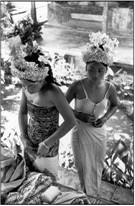Henri Cartier-Bresson
dal 4/8/2005 al 23/10/2005
Segnalato da
4/8/2005
Henri Cartier-Bresson
Scottish National Gallery of Modern Art, Edinburgh
A retrospective

The work of one of the most influential photographers of the twentieth century – Henri Cartier-Bresson – will be explored in a major exhibition at the Dean Gallery in Edinburgh this summer. The largest exhibition ever staged in Britain, this comprehensive retrospective, created by the Henri Cartier-Bresson Foundation in Paris and toured by Magnum Photos, will feature some 200 photographs spanning his exceptional and prolific career. A selection of Cartier-Bresson’s drawings dating mainly from the 1970s and 1980s will also be included, alongside scrapbooks, original books and reviews, photographs of Cartier-Bresson taken by his contemporaries, and his beloved Leica camera, revealing something of the famously reticent photographer himself. The Dean Gallery will be the only UK venue for this exhibition, which has already toured in France, Spain, Germany and Italy.
Henri Cartier-Bresson was born in Chanteloup, near Paris, in 1908. He trained as a painter under André Lhote and developed a keen interest in Surrealism. He began taking photographs as a casual hobby in the late 1920s, taking shots that showed a Surrealist sense of the bizarre. Inspired by a year spent in West Africa and the photographs of Hungarian photographer Martin Munkacsi, photography began to supplant painting as his main interest.
In the 1930s he travelled widely, living in Mexico and New York, where he took some of his most celebrated photographs. With cameras shrinking in size and becoming increasingly quick to use, Cartier-Bresson became one of a generation of photographers who could move rapidly with his camera and follow the action as it unfolded. He never staged photographs, instead he wanted what he famously called ‘the decisive moment’, when the click of the camera captures an instant of unexpected drama. The ‘decisive moment’ was even employed in his portrait photographs; his portraits of Truman Capote, Arthur Miller, Francis Bacon, Pierre-August Renoir, Samuel Beckett, Henri Matisse and Jean-Paul Sartre are admired for appearing unstaged and spontaneous.
He exhibited and published internationally from the mid-1930s onwards, working for some of the leading journals and reviews of the time, and for several years assisted the great film-director Jean Renoir. He was in France documenting the Second World War when German forces made their advance. Predicting his own capture, he buried his Leica camera in farmland in Vosges and soon after was imprisoned in German concentration camps. After two failed attempts, he successfully escaped in 1943 and retrieved his Leica from its hiding place, where it had remained undiscovered for three years.
In 1947, along with Robert Capa, David Seymour and George Rodger he founded Magnum Photos, a co-operative photography agency. The same year, the Museum of Modern Art in New York held an exhibition of his work. By the 1950s he was established as one of the greatest photographers of all time, having captured seminal events in twentieth-century history such as the liberation of Paris, Mao’s takeover of Beijing, the Spanish civil war and the funeral of Mahatma Ghandi. In 1973, he set down his camera and turned his attentions back to drawing. He oversaw the opening of the Henri Cartier-Bresson Foundation in Paris in 2003 and died in August 2004.
Commenting on the exhibition, Susan Rice, chief executive of Lloyds TSB Scotland said: “The Icons of the 20th Century series has gone from strength to strength and anticipation for the Henri Cartier-Bresson show is enormous. His portraits and his keen eye for changes in society leave an indelible impression on the viewer. We’ve been working with the National Galleries of Scotland for four years, helping to bring major works of art to Scotland for more and more people to enjoy. This exhibition is a wonderful addition to the wide-ranging programme of events that take place in Edinburgh throughout the summer. We’re delighted to be playing our part in helping to cement Scotland’s reputation as a thriving centre for the arts.â€
Further information and images from the NGS Press Office
Telephone 0131 624 6325 / 314 / 332 / 247
NOTES TO EDITORS
1. Henri Cartier-Bresson: The Man, the Image & the World accompanies the exhibition and is published by Thames & Hudson priced £48.00
2. Thames & Hudson are also launching a new biography to coincide with the exhibition: Henri Cartier-Bresson: The Biography is written by Pierre Assouline, priced £19.95. More information from Kate Burvill, Head of Press and Media Relations at Thames & Hudson on 020 7845 5019, k.burvill@thameshudson.co.uk
Anita Miller
Press and Information Officer
National Galleries of Scotland
Bridge Lodge, 70 Belford Road
Edinburgh, EH4 3DE
T: 0131 624 6314
F: 0131 343 3250
E: amiller@nationalgalleries.org
Exhibition created by the Henri Cartier-Bresson Foundation, Paris, and toured by Magnum Photos.
Sponsored by Lloyds TSB Scotland
In association with Bentley Edinburgh
PRESS VIEW: FRIDAY 5 AUGUST 2005, 11.30am – 1pm
Image: Indonesia, Bali, 1949. Ubud. Preparations for the Baris Dance © Magnum Photos
DEAN GALLERY, Scottish National Gallery of Modern Art, 73 Belford Road, Edinburgh
Admission £5.00 (concessions £3.50); free to children under 12



